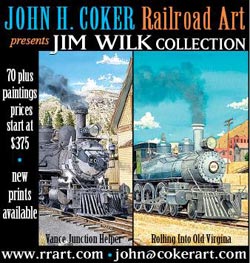

The Baldwin Styles
The Colour & Architecture of US Locomotives
By David Fletcher.
Introduction | Part 1: Origins | Part 2: Baroque Revival | Part 3: Development of Standards | Part 4: Case Studies
Part I: The Origins of the American Locomotive Architecture.
In the US railroad scene, the mention of William Mason instantly evokes thoughts about the Mason Bogie: the famous, decorative, yet least successful innovation of the Mason Works. William Mason's true legacy is his contribution to the American locomotive Architecture, which later influenced Baldwin's aesthetic design.
Mason founded his locomotive works at Taunton Mass.
William Mason. in 1852 after leaving a career in designing/building textile machinery. Between 1853 and 1883 Mason would build some of the most stunningly beautiful locomotives in the US, completing 700 by the year of his death in 1883.
William tended toward perfectionism, and it's been said that he was more interested in locomotive design for the fun of it,
than to actually make any money out of it. To the frustration of some railroads, Mason's perfectionism tended to delay delivery. He was innovative and rarely took accepted design philosophies at face value.
Above all, he believed his locomotives should be beautiful, which they were. This was the perfect union between the functional and the aesthetic. His drive to remove undesirable clutter from the clean lines of a locomotive brought about many innovations in locomotive design. He championed the use of horizontal cylinders on the long framed locomotives such as the 4-4-0. Previously locomotives had slanted cylinders with an awkward appearance. To avoid the ungainly, asymmetric appearance of counterweighted wheels, he preferred the hollow cast iron spoked wheel, and counterweighted these wheels by pouring lead into the spokes.
Historian Art Wallace cites William Mason's background in textiles as a direct contributor to the level of finish he brought to locomotive manufacture. Because the nature of textile processing is that the equipment has to be very cleanly finished so that there are no protrusions to snag anything, Mason had to produce castings that were very high quality to begin with, which were then carefully filled as needed before machining, final polishing, and a multi-stage painting process produced an impeccable finish.
As M.N. Forney, an authority in motive power (as in Forney locomotives and editor of the Railway Gazette), once said of William Mason:
"He was a wonderfully ingenious man and combined with his ingenuity a high order of artistic sense, so that his work was always most exquisitely designed. It might be said of his locomotives that they are melodies cast and wrought in metal."
 |
| William Mason's first locomotive of 1853 - note the very clean horizontal and vertical lines, use of classical elements and symmetry of fittings across the boiler top. Note the even spacing of boiler top fittings.(drawing by Art Wallance) |
With Mason's entry into locomotive design in 1852 came some notable changes to the locomotive form and decoration, which ultimately became the architectural standard for US locomotive design by the 1870s, adopted by most US builders. This was the period of Industrial artistry, the High Victorian period, where buildings as well as machinery were highly appointed and coordination of form, colour and decoration was paramount.
Leading to the 1850s, locomotive design was essentially functional - form followed function, and with a bit of paint and decoration, even an ungainly looking machine could look welcoming. With Mason's first locomotive in 1852, symmetry, careful alignment of components and clear horizontal and vertical lines transformed the locomotive to a rolling work of classical Architecture. Whether to show his love of classical architecture, or simply acting as a commercial sculptor responding to the desires of the community, Mason imported classical concepts into his locomotive design over the two decades that followed. The most notable element to come from the Mason works in the mid 1850s was the development of the 'ringed' or 'fluted' dome, used as a sand box on the boiler top, and as a casing around the steam dome. This became one of the most recognized elements of US locomotive design, with almost all US builders adopting their own version by the 1870's. To be sure, the ringed dome pre-dated Mason and dates back in some form to the UK 1830's. However, Mason tended to champion and refine the details leading to wide acceptance of the concept. The fluted dome itself was essentially inspired by classical column elements, with the moldings influenced by the classical Tuscan and Doric orders. Sand box tops reflected the many elaborate classical urn lids adorning classical revival architecture.
 |
| Typical Baldwin 4-4-0 of the late 1840's, early 1850's - note the angled cylinders and clutter on the boiler top. |
 |
| Jenny Lind, 1838 UK, use of fluted classical form for the dome casing. |
 |
| William Mason 4-4-0 of 1855 - note the very clear use of classical pilaster for the steam dome and early Mason ringed sand box. |
 |
| William Mason 4-4-0 of 1857 - The archetypal US 4-4-0 is complete, ringed domes and classical lines. By the 1870s many of the 4-4-0s built in the US looked very much like this early example. |
Other architectural features also adorned US locos, including cabs with arched windows set to classical proportion, and steam chests corniced in classical form. The cornice, window head, windows and cab panels on a typical 1870s Baldwin 8-18-C 4-4-0 is derived from Doric Order entablature, pilasters, and moldings.
 |
| B&O #25 'William Mason', note classical beads to steam chests. The locomotive is much rebuilt and would have originally looked much like 'Amazon' - see below. |
 |
| Typical Baldwin wood cab of the 1870s - note the cornice at window head, with classical entablature above, sharing much in common with the Doric Order. The window mullions basically replicate the columns. |
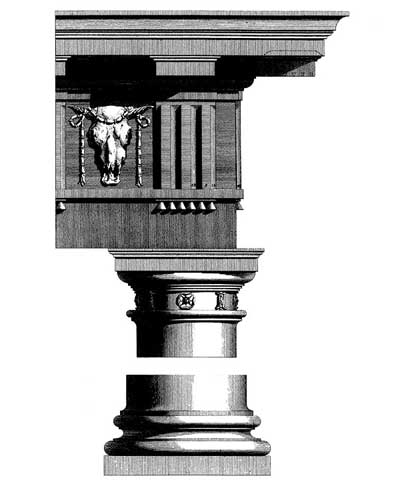 |
 |
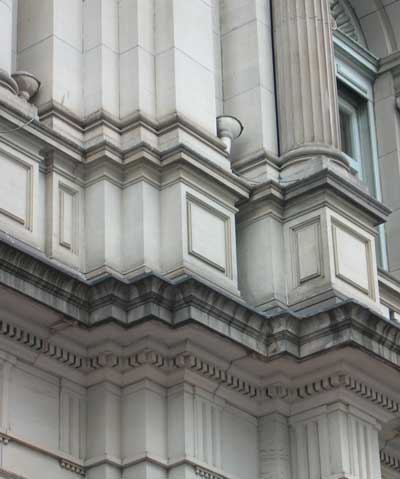 |
| Doric Order of column and entablature above. | ||
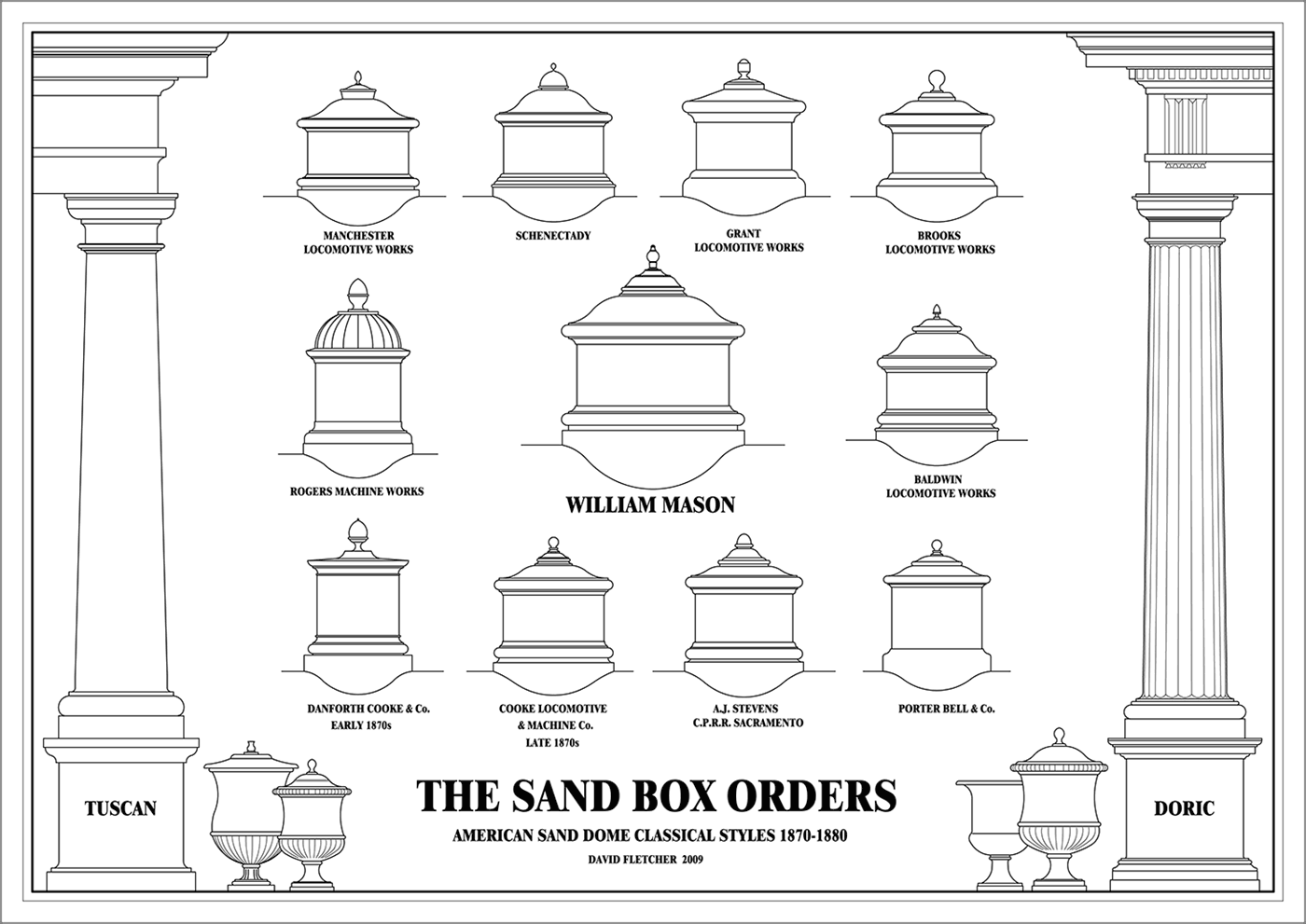 |
||
By the 1870s, most US locomotive builders were engulfed in the classical revival styles. While most builders followed the classical concepts in their locomotive design, each had their own distinctive style, and via analysis of features such as the sand domes alone, it is possible to discern the original builder of a locomotive.
 |
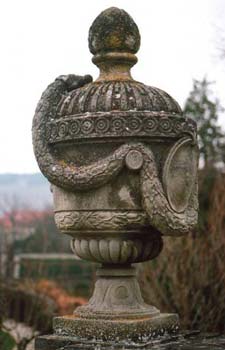 |
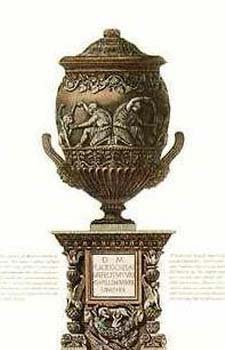 |
 |
Where classical pilasters formed the basis of the ringed dome, urn lids inspired the sand box tops. |
|||
In terms of paint and colour more and more is becoming known about the colour intent of the locomotive builders. Two colour lithographs of the late 1840s and early 1850s from the Baldwin Locomotive works indicate the intent of the day. Like the locomotive's cluttered lines, many different colours are used highlighting each locomotive element only adding to the cluttered appearance.
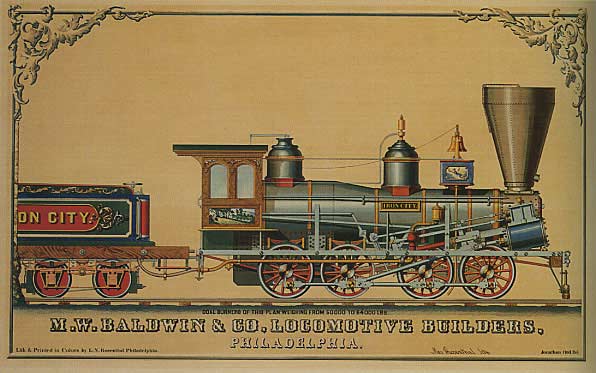 |
| Late 1840s Baldwin 0-8-0 - note extensive use of green blue and red paint on the different locomotive elements. |
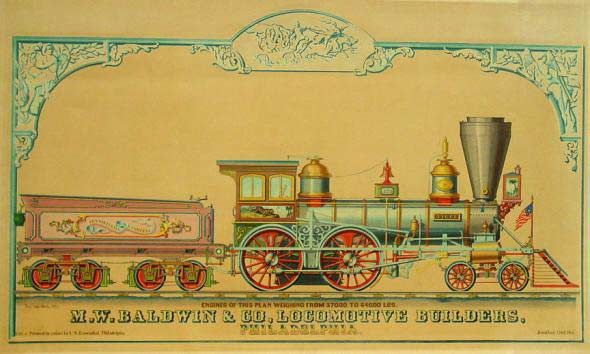 |
| The famous Baldwin 'Tiger' of 1856 - many colours used to decorate the locomotive, including two shades of purple/pink on the tender sides along with highlights of red and green on the locomotive's elements. |
In contrast, Mason believed in the 'Less is more' approach, where bulk areas of single colour best highlight the loco's form as a whole, without the distraction of multiple colours adorning each separate element. Surviving lithographs from the Mason works indicate Mason's approach. The 'Amazon' 4-4-0 of 1856 indicates a Dark Blue engine with red wheels. The dark blue is used across the entire engine, except for the red wheels and boiler jacket.
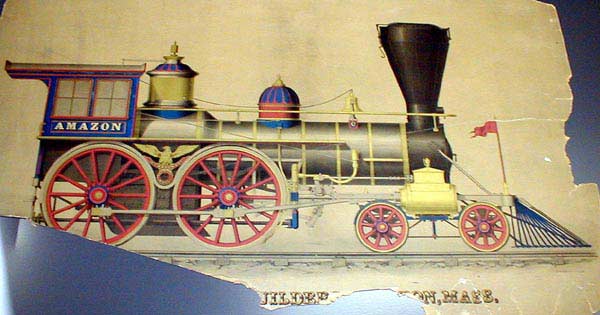 |
| Mason's 1856 'Amazon'. |
 |
| Mason's 1857 'Phantom'. |
The Lithograph of Mason's 4-4-0 'Phantom' from 1857 is similarly decorated, and the tender sides and domes are simply lined using gold leaf and Red. Notable are the simple use of lines and bands of colour, rather than floral decoration. Most importantly, only two colours are used, red and blue. Below the running boards the dominant colour is red, with blue touches, while above the boards and dominant colour is blue, with red highlights.
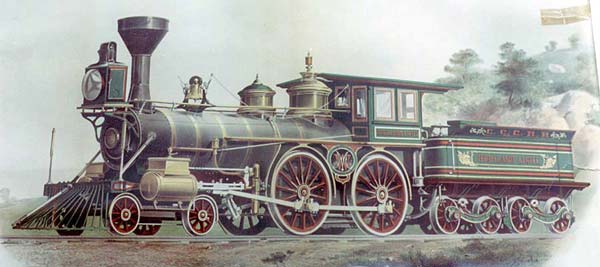 |
| Mason's 1867 'Highland Light'. |
The coloured lithograph of Mason's most famous 4-4-0, the 'Highland Light' of 1867 indicates the very same principle still in use by Mason some 10 years later, however this time, the engine is painted a dark green colour with red wheels. In all cases, as was customary in the US, boilers were jacketed in Russia Iron, an unpainted pressure and heat treated iron jacket with a natural gun metal gray colour. By the mid 1870s other builders followed Mason's lead in developing simply lined and decorated machines with fewer colours.
Please use the navigation links below to continue to the next section.
Introduction | Part 1: Origins | Part 2: Baroque Revival | Part 3: Development of Standards | Part 4: Case Studies

